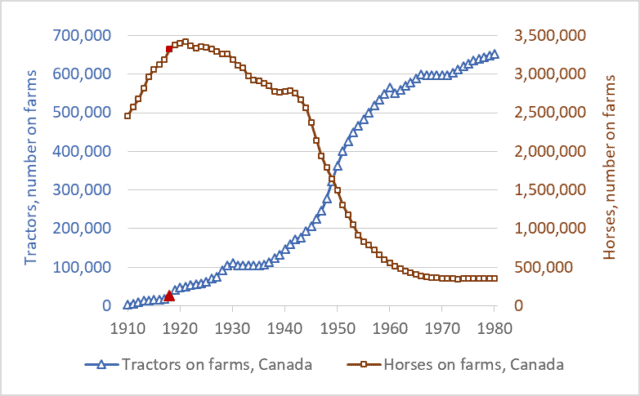2018 marks the 100th anniversary of the beginning of input-dependent farming—the birth of what would become modern high-input agriculture. It was in 1918 that farmers in Canada and the US began to purchase large numbers of farm tractors. These tractors required petroleum fuels. Those fuels became the first major farm inputs. In the early decades of the 20th century, farmers became increasingly dependent on fossil fuels, in the middle decades most also became dependent on fertilizers, and in the latter decades they also became dependent on agricultural chemicals and high-tech, patented seeds.
This week’s graph shows tractor and horse numbers in Canada from 1910 to 1980. On both lines, the year 1918 is highlighted in red. Before 1918, there were few tractors in Canada. The tractors that did exist—mostly large steam engines—were too big and expensive for most farms. But in 1918 three developments spurred tractor proliferation: the introduction of smaller, gasoline-engine tractors (The Fordson, for example); a wartime farm-labour shortage; and a large increase in industrial production capacity. In the final year of WWI and in the years after, tractor sales took off. Shortly after, the number of horses on farms plateaued and began to fall. Economists Olmstead and Rhode have produced a similar graph for the US.
It’s important to understand the long-term significance of what has unfolded since 1918. Humans have practiced agriculture for about 10,000 years—about 100 centuries. For 99 centuries, there were almost no farm inputs—no industrial products that farmers had to buy each spring in order to grow their crops. Sure, before 1918, farmers bought farm implements—hoes, rakes, and sickles in the distant past, and plows and binders more recently. And there were some fertilizer products available, such as those derived from seabird guano (manure) in the eighteenth and nineteenth centuries. And farmers occasionally bought and sold seeds. But for most farmers in most years before about 1918, the production of a crop did not require purchasing an array of farm inputs. Farm chemicals did not exist, very little fertilizer was available anywhere in the world until after WWII, and farmers had little use for gasoline or diesel fuel. Before 1918, farms were largely self-sufficient, deriving seeds from the previous years’ crop, fertility from manure and nitrogen-fixing crops, and pulling-power from horses energized by the hay and grain that grew on the farm itself. For 99 of the 100 centuries that agriculture has existed, farms produced the animal- and crop-production inputs they needed. Nearly everything that went into farming came out of farming.
For 99 percent of the time that agriculture has existed there were few farm inputs, no farm-input industries, and little talk of “high input costs.” Agricultural production was low-input, low-cost, solar-powered, and low-emission. In the most recent 100 years, however, we’ve created a new kind of agricultural system: one that is high-input, high-cost, fossil-fuelled, and high-emission.
Modern agriculture is also, admittedly, high-output. But this last fact must be understood in context: the incredible food-output tonnage of modern agriculture is largely a reflection of the megatonnes of fertilizers, fuels, and chemicals we push into the system. Nitrogen fertilizer illustrates this process. To produce, transport, and apply one tonne of synthetic nitrogen fertilizer requires an amount of energy equal to almost two tonnes of gasoline. Modern agriculture is increasingly a system for turning fossil fuel Calories into food Calories. Food is increasingly a petroleum product.
The high-input era has not been kind to farmers. Two-thirds of Canadian farmers have been ushered out of agriculture over the past two generations. More troubling and more recent: the number of young farmers—those under 35—has been reduced by two-thirds since 1991. Farm debt is at a record high: nearly $100 billion. And about the same amount, $100 billion, has had to be transferred from taxpayers to farmers since the mid-1980s to keep the Canadian farm sector afloat. Farmers are struggling with high costs and low margins.
This is not a simplistic indictment of “industrial agriculture.” We’re not going back to horses. But on the 100th anniversary of the creation of fossil-fuelled, high-input agriculture we need to think clearly and deeply about our food production future. As our fossil-fuel supplies dwindle, as greenhouse gas levels rise, as we struggle to feed and employ billions more people, and as we struggle with many other environmental and economic problems, we will need to rethink and radically transform our food production systems. Our current food system isn’t “normal”: it’s an anomaly—a break with the way that agriculture has operated for 99 percent of its history. It’s time to ask hard questions and make big changes. It’s time to question the input-maximizing production systems agribusiness corporations have created, and to explore new methods of low-input, low-energy-use, low-emission production.
Rather than maximizing input use, we need to maximize net farm incomes, maximize the number of farm families on the land, and maximize the resilience and sustainability of our food systems.

